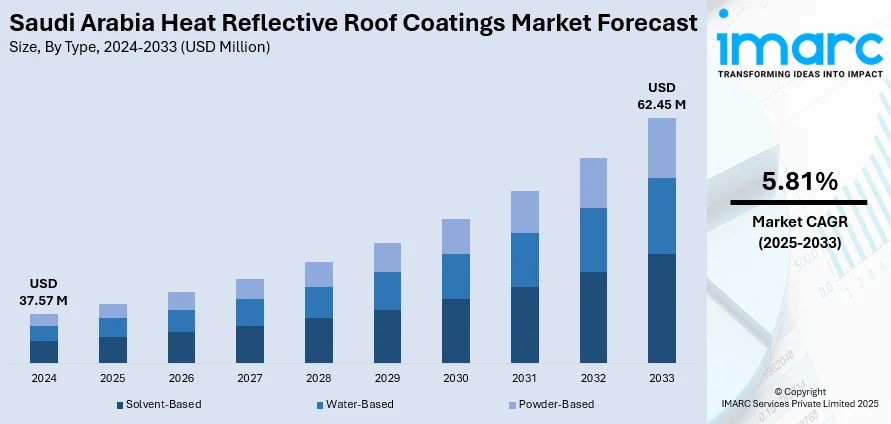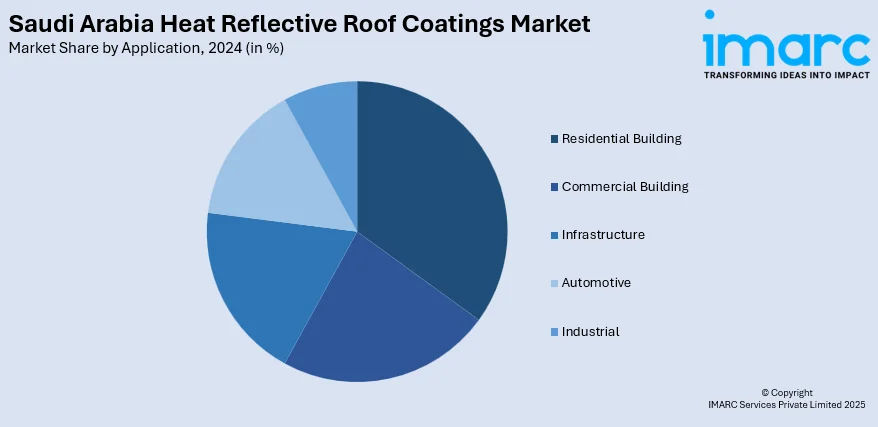
Saudi Arabia Heat Reflective Roof Coatings Market Size, Share, Trends and Forecast by Type, Resin Type, Application, and Region, 2025-2033
Saudi Arabia Heat Reflective Roof Coatings Market Overview:
The Saudi Arabia heat reflective roof coatings market size reached USD 37.57 Million in 2024. Looking forward, IMARC Group expects the market to reach USD 62.45 Million by 2033, exhibiting a growth rate (CAGR) of 5.81% during 2025-2033. The market is expanding due to increasing demand for energy-efficient construction solutions. Rising temperatures and a growing focus on sustainability are driving the adoption of silicone-based coatings, which are improving building performance. This trend supports Saudi Arabia heat reflective roof coatings market share, particularly in the commercial and residential sectors.
|
Report Attribute
|
Key Statistics
|
|---|---|
|
Base Year
|
2024
|
|
Forecast Years
|
2025-2033
|
|
Historical Years
|
2019-2024
|
| Market Size in 2024 | USD 37.57 Million |
| Market Forecast in 2033 | USD 62.45 Million |
| Market Growth Rate 2025-2033 | 5.81% |
Saudi Arabia Heat Reflective Roof Coatings Market Trends:
Sustainability Fuels Demand for Roof Coatings
As sustainability grows in importance in the construction sector, the need for energy-efficient building products is rising, particularly in countries such as Saudi Arabia, where temperature conditions create a need for cooling. Roof coatings that reflect heat are becoming increasingly popular as a primary component in minimizing energy use and enhancing building performance. These coatings serve to keep internal temperatures lower, which means lower use of air conditioning and subsequently lower energy bills and greenhouse gas output. There is a high demand for green infrastructure, and these coatings are proving themselves to be a vital resource in the fight against the environmental effects of conventional roof coverings. In January 2025, the Middle East witnessed a significant boost in the use of heat-reflective roof coatings, driven in large part by the region's emphasis on sustainability. Silicone-based coatings, especially in warm climates, have been shown to enhance energy efficiency. They accomplish this by increasing solar reflectivity, decreasing heat absorption, and cooling the interior of the building. This trend is taking hold in Saudi Arabia, where the extreme ambient temperatures mean that energy efficiency is a priority in residential and commercial structures. As sustainability measures increase in size, heat-reflective roof coatings are becoming a key element in energy-efficient buildings, bolstering the Saudi Arabia heat reflective roof coatings market growth.

Technological Innovations in Cool Roof Coatings
Technological developments have played an important role in the change of the construction sector toward more energy-efficient and environment-friendly solutions. Advances in cool roof coatings are transforming the market, especially with new products that guarantee higher performance and higher energy savings. These developments play a significant role in countries with extreme climates, like Saudi Arabia, where the demand for energy-efficient cooling solutions is becoming more pressing. Specialized coatings not only increase the energy efficiency of buildings but also counter problems like the urban heat island effect, which is increasingly becoming an issue in cities throughout the region. In May 2025, Sika launched its Sikalastic 701 high-performance polyurethane-acrylic hybrid topcoat for increasing solar reflectance and minimizing heat accumulation on roofs. Proven in other parts of the world, such as Dubai and Greece, Sikalastic-701 proved that it could decrease air conditioning loads and increase energy efficiency. Its capacity to minimize thermal stress on roofing materials and high resistance to UV reflectance make it a perfect fit for Saudi Arabia's harsh conditions. With such developments incorporated, the reflective roof coatings market in Saudi Arabia is set for growth. Developers and builders are now choosing next-generation solutions, like Sikalastic-701, to ensure improved building performance, lower maintenance expenses, and environmental sustainability in the long term. This technological advance is quickly driving the region toward energy-efficient buildings.
Saudi Arabia Heat Reflective Roof Coatings Market Segmentation:
IMARC Group provides an analysis of the key trends in each segment of the market, along with forecasts at the country and regional level for 2025-2033. Our report has categorized the market based on type, resin type, and application.
Type Insights:
- Solvent-Based
- Water-Based
- Powder-Based
The report has provided a detailed breakup and analysis of the market based on the type. This includes solvent-based, water-based, and powder-based.
Resin Type Insights:
- Epoxy
- Polyester
- Silicon
- Acrylic
The report has provided a detailed breakup and analysis of the market based on the resin type. This includes epoxy, polyester, silicon, and acrylic.
Application Insights:

- Residential Building
- Commercial Building
- Infrastructure
- Automotive
- Industrial
A detailed breakup and analysis of the market based on the application have also been provided in the report. This includes residential building, commercial building, infrastructure, automotive, and industrial.
Regional Insights:
- Northern and Central Region
- Western Region
- Eastern Region
- Southern Region
The report has also provided a comprehensive analysis of all the major regional markets, which include Northern and Central region, Western region, Eastern region, and Southern region.
Competitive Landscape:
The market research report has also provided a comprehensive analysis of the competitive landscape. Competitive analysis such as market structure, key player positioning, top winning strategies, competitive dashboard, and company evaluation quadrant has been covered in the report. Also, detailed profiles of all major companies have been provided.
Saudi Arabia Heat Reflective Roof Coatings Market News:
- May 2025: Sika introduced Sikalastic 701, a high-performance polyurethane-acrylic hybrid top-coat for cool roofs. The product, tested in regions like Dubai and Greece, enhances solar reflectivity, reduces energy consumption, and combats the urban heat island effect, boosting the heat reflective roof coatings market in Saudi Arabia.
Saudi Arabia Heat Reflective Roof Coatings Market Report Coverage:
| Report Features | Details |
|---|---|
| Base Year of the Analysis | 2024 |
| Historical Period | 2019-2024 |
| Forecast Period | 2025-2033 |
| Units | Million USD |
| Scope of the Report |
Exploration of Historical Trends and Market Outlook, Industry Catalysts and Challenges, Segment-Wise Historical and Future Market Assessment:
|
| Types Covered | Solvent-Based, Water-Based, Powder-Based |
| Resin Types Covered | Epoxy, Polyester, Silicon, Acrylic |
| Applications Covered | Residential Building, Commercial Building, Infrastructure, Automotive, Industrial |
| Regions Covered | Northern and Central Region, Western Region, Eastern Region, Southern Region |
| Customization Scope | 10% Free Customization |
| Post-Sale Analyst Support | 10-12 Weeks |
| Delivery Format | PDF and Excel through Email (We can also provide the editable version of the report in PPT/Word format on special request) |
Key Questions Answered in This Report:
- How has the Saudi Arabia heat reflective roof coatings market performed so far and how will it perform in the coming years?
- What is the breakup of the Saudi Arabia heat reflective roof coatings market on the basis of type?
- What is the breakup of the Saudi Arabia heat reflective roof coatings market on the basis of resin type?
- What is the breakup of the Saudi Arabia heat reflective roof coatings market on the basis of application?
- What is the breakup of the Saudi Arabia heat reflective roof coatings market on the basis of region?
- What are the various stages in the value chain of the Saudi Arabia heat reflective roof coatings market?
- What are the key driving factors and challenges in the Saudi Arabia heat reflective roof coatings market?
- What is the structure of the Saudi Arabia heat reflective roof coatings market and who are the key players?
- What is the degree of competition in the Saudi Arabia heat reflective roof coatings market?
Key Benefits for Stakeholders:
- IMARC’s industry report offers a comprehensive quantitative analysis of various market segments, historical and current market trends, market forecasts, and dynamics of the Saudi Arabia heat reflective roof coatings market from 2019-2033.
- The research report provides the latest information on the market drivers, challenges, and opportunities in the Saudi Arabia heat reflective roof coatings market.
- Porter's five forces analysis assist stakeholders in assessing the impact of new entrants, competitive rivalry, supplier power, buyer power, and the threat of substitution. It helps stakeholders to analyze the level of competition within the Saudi Arabia heat reflective roof coatings industry and its attractiveness.
- Competitive landscape allows stakeholders to understand their competitive environment and provides an insight into the current positions of key players in the market.
Need more help?
- Speak to our experienced analysts for insights on the current market scenarios.
- Include additional segments and countries to customize the report as per your requirement.
- Gain an unparalleled competitive advantage in your domain by understanding how to utilize the report and positively impacting your operations and revenue.
- For further assistance, please connect with our analysts.
 Request Customization
Request Customization
 Speak to an Analyst
Speak to an Analyst
 Request Brochure
Request Brochure
 Inquire Before Buying
Inquire Before Buying




.webp)




.webp)












